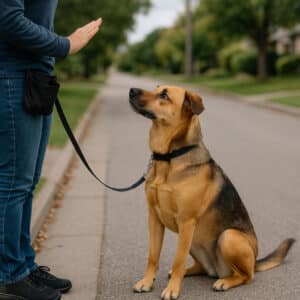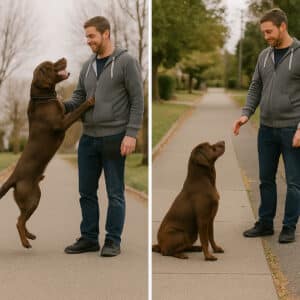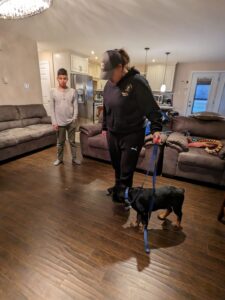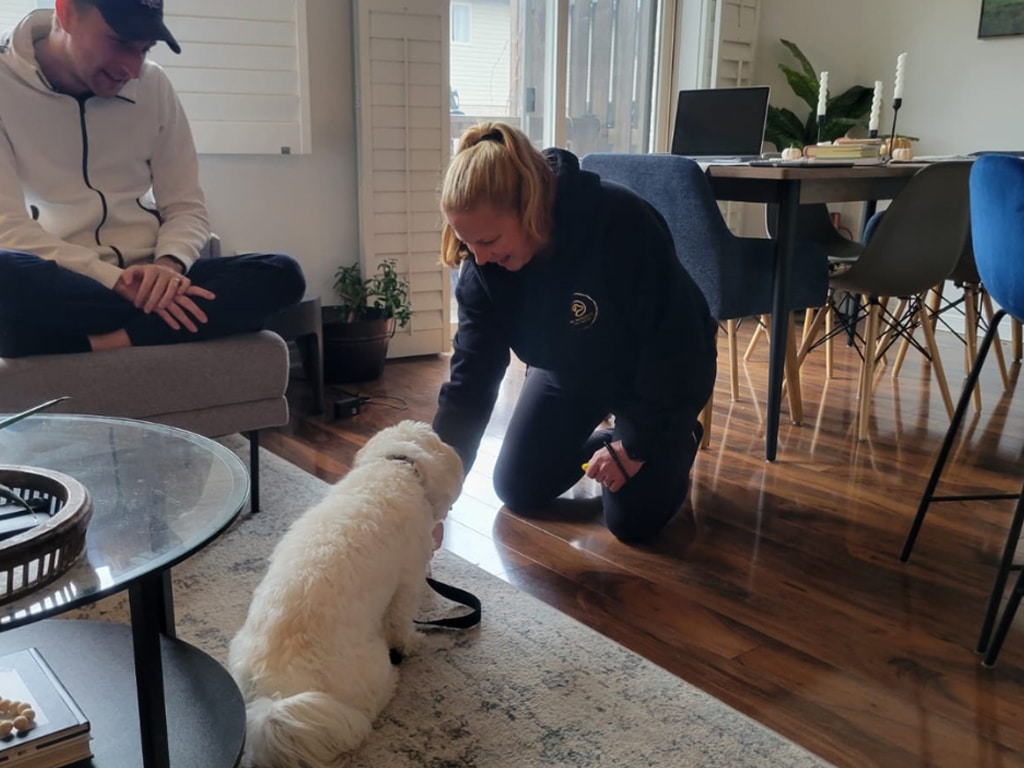If you’re only rewarding your dog when they get it perfect, you’re missing the point. The real secret to successful training? Rewarding progress. It’s not about waiting for flawless behaviour — it’s about reinforcing every step your dog takes in the right direction. At K9 Principles, we’ve seen how rewarding progress transforms not just dogs, but their owners too. This is the key to confident, motivated learning, and it’s the mindset we teach every day in our private sessions for dog training in Hamilton.
Understanding the Role of Rewards in Dog Training
At the heart of all dog training lies one simple principle: behaviour that gets rewarded gets repeated. Your dog isn’t trying to be stubborn or push your buttons — they’re constantly asking, “What works?” When you use rewards effectively, you give them a crystal-clear answer. In our approach to Hamilton dog training, rewards are more than just tools. They’re how we communicate, how we build trust, and how we motivate dogs to keep trying. A well-timed reward says, “Yes! That’s what I wanted.” It tells your dog that their effort mattered. And once they understand that, they’ll offer more of that behaviour, again and again. Inconsistent or late rewards muddy the message. Imagine working a job where your pay was hit-or-miss. Would you keep showing up? Probably not. Your dog feels the same. That’s why at K9 Principles, our first focus in any dog training in Hamilton session is helping owners master their timing and reward delivery. Once that foundation is in place, everything else becomes easier.
Why Rewarding Progress is More Powerful Than Rewarding Only Perfection
Many new dog owners wait until their dog performs the full behaviour perfectly before offering praise or treats. It sounds logical — but in reality, it slows down learning and crushes motivation. Perfection is a destination, and most dogs need a clear, rewarding path to get there. That path is built by reinforcing progress. Let’s say you’re teaching your dog to stay. If you only reward them after a full minute, they’ll likely give up long before they reach it. But if you start by rewarding a one-second stay, then three, then five, you create momentum. Your dog learns that trying pays off. This is how we train in our Hamilton dog training programs — we break complex behaviours into teachable steps and celebrate each success. That way, the dog is always moving forward, always winning, always learning. It’s not just about treats, either. Dogs thrive on emotional reinforcement. If your body language, tone, and facial expressions reflect genuine pride in their effort, that’s just as valuable as a snack. In every session of our dog training in Hamilton, we coach owners to become their dog’s biggest cheerleader — because when your dog feels successful, they become eager to keep learning.
The Psychology Behind Reward-Based Training
Reward-based dog training isn’t a trend. It’s backed by decades of research in behavioural science. Dogs are what we call operant learners — they learn by consequence. If a behaviour leads to something they like, they’ll try it again. If it leads to nothing or something they don’t like, they’ll avoid it. That’s why punishment-based approaches often backfire. You might suppress the behaviour in the moment, but you haven’t taught your dog what to do instead. At K9 Principles, we focus on reinforcing what we want — not punishing what we don’t. This proactive mindset helps dogs feel safe, motivated, and clear about how to succeed. In our dog training in Hamilton sessions, we see first-hand how quickly dogs start experimenting once they realise their choices earn rewards. That’s where the real transformation happens. You’re no longer managing behaviour — you’re shaping it.
Recognising Small Wins in Dog Training

Progress often looks unremarkable to the untrained eye. But those tiny shifts in behaviour are the foundation of everything. A dog who used to bark non-stop at the window might now glance, hesitate, then look away. That hesitation? That’s gold. It’s a window of self-control, and it needs to be rewarded. In Hamilton dog training, we often meet owners who think their dog hasn’t made any progress — until we point out these micro-wins. A puppy who can now hold a sit for two seconds instead of one. A rescue dog who chooses to walk away from a distraction rather than lunge. These aren’t final results — they’re steps in the right direction. And when we reward them, we reinforce the dog’s belief that they’re on the right track. It’s this belief that fuels confidence and keeps learning alive.
The Difference Between Bribery and Rewards
This one comes up a lot in our dog training in Hamilton consultations: “Am I just bribing my dog?” It’s a fair question, and the answer is all about timing. A bribe is shown before the behaviour. It’s like waving a treat and saying, “Come here and I’ll give you this.” A reward comes after the behaviour, reinforcing the dog’s decision. In the early stages of dog training, we might use a lure to guide behaviour — but we quickly phase it out. The goal is for the dog to respond to your cue, not the sight of a treat. That’s why we work closely with clients at K9 Principles to make sure their rewards are teaching, not bribing. When done right, your dog learns to trust that good behaviour leads to good things — without needing to see the prize first.
Choosing the Right Reward for Your Dog
Not all dogs are food-driven. And even those that are will have preferences. What works in your quiet home might fall flat in a busy park. That’s why reward choice matters — and why it needs to adapt based on the dog and the context. We break rewards into three main types in our Hamilton dog training sessions: food, play, and social interaction. High-value food (like chicken or cheese) is great for new behaviours or tough environments. Toys are excellent for active, high-energy dogs. Praise, petting, or access to preferred spaces work well for more sensitive or socially motivated dogs. Finding what your dog truly values is one of the first goals in effective dog training — because when the reward matters, the learning sticks.
Timing Your Rewards for Maximum Impact
In dog training, timing can make or break the lesson. If you reward too early, your dog might associate the treat with the wrong behaviour. If you reward too late, the moment is lost, and confusion sets in. We often talk about the “two-second window” — that’s how long you have to reinforce the behaviour you’re aiming for. At K9 Principles, we train owners from our Hamilton dog training lessons to mark behaviour instantly, either with a clicker or a verbal “yes,” and follow that up with a reward. This keeps your dog clear and confident.
How to Gradually Reduce Rewards Without Losing Progress
Once your dog understands a behaviour, you don’t want to get stuck in a pattern where they’ll only work if they see a treat. That’s where we start shifting to a variable reward schedule. This is a critical step in all good dog training in Hamilton programs. It means rewarding some of the time, not every time, and keeping the dog guessing in a good way.

Common Mistakes Owners Make When Rewarding Progress
Let’s be honest — most mistakes in dog training don’t come from the dog. They come from the human. That’s not a criticism; it’s just reality. At K9 Principles, our job isn’t just to train the dog — it’s to teach the owner how to be an effective communicator. And that starts with understanding what progress actually looks like. The biggest error we see in Hamilton dog training is missing the moment. Owners wait for the final picture-perfect sit or down or recall, and ignore all the tiny improvements that led there. If you wait for 100%, you miss the 70% that could have been reinforced — and as a result, you don’t get to 100%. Another common problem is over-rewarding the wrong behaviour. For example, giving a treat after the dog breaks a stay or jumps up, simply to end the behaviour. That teaches the dog that being pushy works. That’s not the dog’s fault — it’s just poor timing or unclear criteria.
Building Consistency Across All Family Members
This is a game-changer. If you’re the only one doing the training and everyone else in the household is letting things slide, your dog will quickly become confused. Dogs aren’t mind-readers — they thrive on consistency. That means everyone who interacts with the dog needs to be on the same page about cues, expectations, and rewards. In our dog training in Hamilton programs, we often invite the whole family to join in the sessions. We create simple systems so that everyone knows exactly how to reward progress, use consistent cues, and avoid mixed messages. You’d be amazed how often one person accidentally undoes another’s work. Mom teaches a polite sit for greetings, but Dad still pets the dog when it jumps up. Kids are told not to feed scraps, but Grandpa sneaks toast under the table. The result? A confused dog who doesn’t know what works anymore. This inconsistency creates frustration on both sides. By creating structure and shared goals, we help families build a united front in their Hamilton dog training efforts — and the dogs absolutely thrive.
How K9 Principles Uses Rewarding Progress in Private Training

At K9 Principles, we don’t wait for perfection. We reward progress from day one. In every private dog training in Hamilton session, our focus is on reinforcing effort, not outcome. When a dog offers any piece of the desired behaviour, we mark and reward it. That builds confidence. It also builds clarity — the dog starts to understand the game. They realise their human is paying attention and rewarding their attempts, not just their final result. This mindset shift also helps the owner. Instead of feeling frustrated that their dog isn’t “there yet,” they start to see and celebrate the journey. They notice the 10% improvement, the half-second pause, the look-away from a trigger. And because they reward it, that progress sticks and grows. We structure every stage of our Hamilton dog training programs to set dogs up for success. That means making sure the environment, the timing, and the reward strategy are all aligned. There’s no guessing. The dog knows what’s working. The owner sees the transformation. That’s how real progress happens.
Real-Life Examples of Rewarding Progress in Action
While we won’t share individual case stories here, I can tell you that rewarding progress is the single most powerful shift any dog owner can make. When a dog who used to bolt at every distraction starts checking in with their owner — even just once — we reward it. When a reactive dog chooses to sniff the grass instead of barking, that tiny decision gets reinforced. When a high-energy puppy offers a sit instead of jumping, even for half a second, we treat it like a breakthrough. This is the kind of work we do every day in our dog training in Hamilton sessions. We aren’t just managing behaviour. We’re shaping it, one good decision at a time. We’re creating a pattern where the dog believes, deeply and consistently, that trying leads to good outcomes. That belief is what makes dogs engaged, focused, and willing to learn — not just in training sessions, but in life.
The Long-Term Benefits of Rewarding Progress for Behaviour and Bonding
Training isn’t just about getting your dog to behave. It’s about building a relationship rooted in trust, cooperation, and shared success. When you reward progress, your dog doesn’t just learn what to do — they learn how to think. They start to offer behaviours instead of waiting to be told. They become proactive, not reactive. And that shift changes everything. In the long term, this approach leads to dogs who are more adaptable, more confident, and more emotionally stable. It also creates owners who feel empowered instead of overwhelmed. That’s the real gift of consistent, thoughtful dog training. And when that training is rooted in rewarding progress, not perfection, it becomes a lifestyle. It’s not about strict routines or rigid control. It’s about communication. Collaboration. And joy. In every corner of our Hamilton dog training programs, this philosophy shines through. Whether we’re working on recall, impulse control, leash walking, or just helping a shy dog settle into a new home, we meet them where they’re at. We reinforce effort. We celebrate the try. And the results speak for themselves.
When and How to Introduce Variable Rewards
As your dog becomes more fluent in a behaviour, you can start mixing things up. This doesn’t mean being inconsistent — it means being strategic. Variable rewards keep your dog guessing, which actually boosts focus. They know the reward might come — they just don’t know when or what it will be. That uncertainty keeps them engaged. It’s like a surprise party — always exciting, always worth showing up for. At K9 Principles, we teach our dog training in Hamilton clients how to blend fixed and variable rewards depending on the stage of learning. Early on, we reward every success. Later, we switch it up. A jackpot for an especially good effort. A quick “yes” and move on for the basics. This variety strengthens behaviour and keeps training fun. It also makes your dog more resilient in real-world situations where instant rewards might not be possible.
Troubleshooting: What to Do if Your Dog Loses Motivation
Even the most enthusiastic dogs hit a plateau sometimes. Maybe they start ignoring your cues. Maybe they stop taking treats. Or maybe they just seem uninterested in training altogether. When this happens, it’s easy to assume your dog is being stubborn. But from our experience working in Hamilton dog training, a drop in motivation is nearly always a signal — not defiance. First, ask yourself: is the reward still valuable? Dogs get bored, just like we do. If you’ve been using the same old biscuit day in and day out, your dog might have lost interest. This is especially common in high-distraction settings. A dry biscuit might be fine in the kitchen, but it’s no match for a squirrel in the park. That’s why our reward strategies in dog training in Hamilton are dynamic. We constantly adapt based on the environment and the dog’s energy levels. Next, consider the difficulty. If your dog keeps failing at a cue, chances are you’re asking too much too soon. Go back to a simpler version of the behaviour and reward generously. Rebuild their confidence. Often in our Hamilton dog training sessions, we’ll spend a few minutes doing behaviours the dog already knows really well — sits, touches, eye contact — just to get that rhythm of success flowing again. And finally, check your own energy. Dogs are remarkably sensitive to human tone and body language. If you’re flat, distracted, or frustrated, they pick up on it immediately. Bring some joy back into the work. Use a silly voice. Get on the floor. Make it a game again. You’ll be amazed how quickly your dog perks up.
Final Thoughts: Making Rewards a Lifelong Habit
Here’s the truth we teach in every dog training in Hamilton session: training never really ends. It evolves. Your dog is learning all the time, whether you’re actively shaping behaviour or not. So the question becomes: what are you reinforcing, and are you doing it with intention? When you build a habit of rewarding progress — not just outcomes — your dog becomes more than obedient. They become confident, engaged, and connected. You stop managing problems and start building skills. You stop reacting to bad behaviour and start celebrating good decisions. At K9 Principles, this isn’t a gimmick. It’s the foundation of our entire approach to Hamilton dog training. From the first puppy session to advanced off-lead control, our goal is always the same: reinforce the try. Catch the improvement. And create a dog who loves learning, because it leads to success. We don’t chase perfection. We build it — slowly, intentionally, and with joy.
Ready to raise a dog who can handle anything life throws their way? It starts now. It starts here. Let’s get to work—with K9 Principles, the trusted name in dog training in Hamilton.
That’s real dog training. And it starts right here.
Contact us for more information:
- Name: K9 Principles
- Address: Haldimand County, Greater Hamilton Area, Burlington, and Most of Norfolk County
- Phone: 289 880-3382
- Email: k9principlesinc@gmail.com
- Website: www.k9principles.ca
FAQs
-
A1. Not if it’s done right. In the early stages of dog training, frequent rewards help create clarity and confidence. As behaviours become fluent, you gradually reduce the reward frequency and variety. This teaches your dog that rewards are earned, not automatic. At K9 Principles, we structure every phase of training so your dog stays motivated without becoming reliant.






